Romualdo Formation
| Romualdo Formation Stratigraphic range: Albian ~111–108 Ma | |
|---|---|
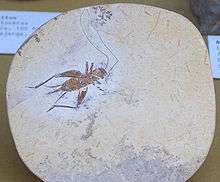 Fossil of a cricket from the Romualdo Formation | |
| Type | Geological formation |
| Unit of | Santana Group |
| Underlies | Exu & Arajara Formations |
| Overlies | Crato & Ipubi Formations |
| Thickness | 2–10 m (6.6–32.8 ft) |
| Lithology | |
| Primary | Mudstone |
| Other | Limestone, shale |
| Location | |
| Coordinates | 7°12′S 39°18′W / 7.2°S 39.3°WCoordinates: 7°12′S 39°18′W / 7.2°S 39.3°W |
| Approximate paleocoordinates | 12°12′S 10°42′W / 12.2°S 10.7°W |
| Region | Pernambuco, Piauí & Ceará |
| Country |
|
| Extent | Araripe Basin |
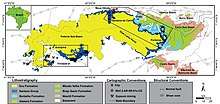 Extent of the Santana Group, to which the Romualdo Formation belongs, in blue | |
The Romualdo Formation is a geologic Konservat-Lagerstätte in northeastern Brazil's Araripe Basin where the states of Pernambuco, Piauí and Ceará come together. The geological formation, previously designated as the Romualdo Member of the Santana Formation, named after the village of Santana do Cariri, lies at the base of the Araripe Plateau. It was discovered by Johann Baptist von Spix in 1819. The strata were deposited during the Albian stage of the Early Cretaceous in a lacustrine rift basin with shallow marine incursions of the proto-Atlantic. At that time, the South Atlantic was opening up in a long narrow shallow sea.
The Romualdo Formation earns the designation of Lagerstätte due to an exceedingly well preserved and diverse fossil faunal assemblage. Some 25 species of fossil fishes are often found with stomach contents preserved, enabling paleontologists to study predator–prey relationships in this ecosystem. There are also fine examples of pterosaurs, reptiles and amphibians, invertebrates (particularly insects), crocodylomorphs, and plants. Even dinosaurs are represented (Spinosauridae, Tyrannosauroidea, Compsognathidae). The unusual taphonomy of the site resulted in limestone accretions that formed nodules around dead organisms, preserving even soft parts of their anatomy. In preservation, the nodules are etched away with acid, and the fossils often prepared by the transfer technique.[1]
Local mining activities for cement and construction damage the sites. Trade in illegally collected fossils has sprung up in the last decade, driven by the remarkable state of preservation and beauty of these fossils and amounting to a considerable local industry. An urgent preservation program is being called for by paleontologists.
In addition, the weathering of Romualdo Formation rocks has contributed soil conditions unlike elsewhere in the region. The Araripe manakin (Antilophia bokermanni) is a very rare bird that was discovered only in the late 20th century; it is not known from anywhere outside the characteristic forest that grows on the Chapada do Araripe soils formed ultimately from Romualdo Formation rocks.
Geology and dating
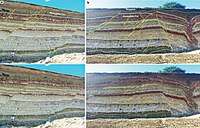
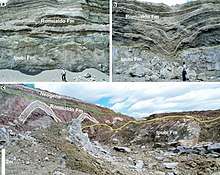
The Crato Formation was previously considered the lowest member of the then Santana Formation, but has been elevated to a formal formation. The Crato Formation is the product of a single phase, where complicated sequence of sediment strata reflect changeable conditions in the opening sea. The age of the Romualdo Formation, formerly known as the Romualdo Member of the Santana Formation, has been controversial, though most workers have agreed that it lies on or near the Aptian-Albian boundary, about 112 million years ago. Nevertheless, a Cenomanian age cannot be ruled out.[2][3]
The extent of the Crato unit and its relationship to the Romualdo Formation had long been ill defined. It was not until a 2007 volume on the unit by Martill, Bechly and Loveridge that the Crato Formation was given a formal type locality, and was formally made a distinct formation separate from the Romualdo Formation, which is about 10 Ma younger.[2]
Fossil content
Archosaurs
Indeterminate remains of non-avian theropods, avialans, ornithischians, and possibly oviraptorosaurs have been found in Estado do Ceara, Brazil.[4]
Color key
|
Notes Uncertain or tentative taxa are in small text; |
| Dinosaurs, crocodylomorphs, and birds of the Romualdo Formation | ||||
|---|---|---|---|---|
| Genus | Species | Presence | Notes | Images |
|
A. limai[4] |
Geographically present in Estado do Ceara, Brazil.[4] |
Spinosauridae. "Rostral portion of [a] skull."[5] Junior synonym of Irritator challengeri. |
||
|
I. challengeri[4] |
Geographically present in Estado do Ceara, Brazil.[4] |
Spinosauridae, "partial skull" |
 | |
|
M. asymmetrica[4] |
Geographically present in Estado do Ceara, Brazil.[4] |
|||
|
S. placidus[4] |
Geographically present in Estado do Ceara, Brazil.[4] |
"Partial postcranium."[6] |
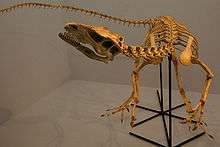 | |
|
A. gomesii |
Romualdo Formation |
Type specimen 423-R is a single skull articulating with part of a lower jaw. A more complete specimen, AMNH 24450, is at the American Museum of Natural History. |
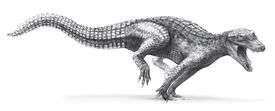 Restoration of an Araripesuchian | |
Pterosaurs
Color key
|
Notes Uncertain or tentative taxa are in small text; |
| Pterosaurs of the Romualdo Formation | |||
|---|---|---|---|
| Genus | Species | Presence | Images |
| Anhanguera | * A. blittersdorffi
|
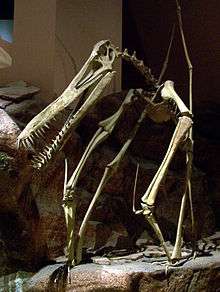 | |
| Araripedactylus | Araripedactylus dehmi | ||
| Araripesaurus | Araripesaurus castilhoi | ||
| Barbosania[7] | Barbosania gracilirostris | ||
| Brasileodactylus | Brasileodactylus araripensis | ||
| Cearadactylus | Cearadactylus atrox | ||
| "Cearadactylus" | "Cearadactylus" ligabuei | ||
| Maaradactylus | Maaradactylus kellneri | ||
| Santanadactylus |
|
||
| Tapejara | Tapejara wellnhoferi | 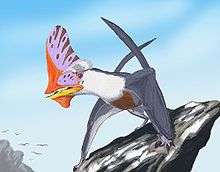 | |
|
Thalassodromeus sethi |
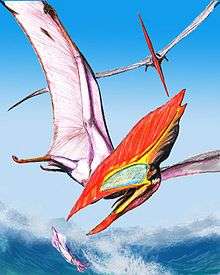 | ||
|
Tropeognathus mesembrinus |
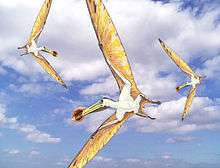 | ||
|
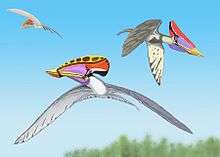 | ||
| Unwindia | Unwindia trigonus | ||
Turtles
| Turtles of the Romualdo Formation | ||||
|---|---|---|---|---|
| Genus | Species | Presence | Notes | Images |
| Santanachelys | S. gaffneyi | [8] | 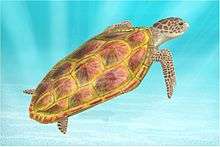 | |
| Cearachelys | C. placidoi | [9] | 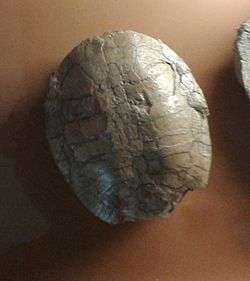 | |
| Araripemys | A. barretoi | [10] | ||
| Euraxemys | E. essweini | [11] | ||
| Brasilemys | B. josai | [12] | ||
Fish
- Araripelepidotes
- Beurlenichthys ouricuriensis[13]
- Brannerion[14]
- Calamopleurus[14]
- Cladocyclus[14][15]
- Enneles audax[16]
- Iemanja palma[17]
- Lepidotes wenzai[12]
- Microdon penalvai[12]
- Notelops[14]
- Obaichthys[12]
- Oshunia brevis[12]
- Paraelaps
- Placidichthys bidorsalis[18]
- Rhacolepis[14]
- Ehinobatos beurleni[12]
- Tharrhias[14]
- Tribodus limae[12]
- Vinctifer[14][19]
See also
References
- ↑ Maisey et al., 1991, pp.99-103
- 1 2 Martill et al., 2007
- ↑ Martill, 2007
- 1 2 3 4 5 6 7 8 9 10 11 12 13 Weishampel, 2004, pp. 563–570
- ↑ "Table 4.1," in Weishampel, et al. (2004). Page 73.
- ↑ "Table 5.1," in Weishampel, et al. (2004). Page 114.
- ↑ Elgin & Frey, 2011
- ↑ Santanachelys gaffneyi at Fossilworks.org
- ↑ Juazeiro do Norte at Fossilworks.org
- ↑ Araripemys barretoi type locality at Fossilworks.org
- ↑ Crato at Fossilworks.org
- 1 2 3 4 5 6 7 Chapada do Araripe at Fossilworks.org
- ↑ Casa de Pedra at Fossilworks.org
- 1 2 3 4 5 6 7 Fara et al., 2005, p.152
- ↑ Buxéxé, Santana do Cariri at Fossilworks.org
- ↑ Enneles audax
- ↑ Iemanja palma
- ↑ Placidichthys type locality at Fossilworks.org
- ↑ Ze Gomes at Fossilworks.org
Bibliography
- Cavalcanti Duque, Rudah Ruano, and Alcina Magnólia Franca Barreto. 2018. Novos Sítios Fossilíferos da Formação Romualdo, Cretáceo Inferior, Bacia do Araripe, Exu, Pernambuco, Nordeste do Brasil - New Fossiliferous Sites of the Romualdo Formation, Lower Cretaceous, Araripe Basin, Exu, Pernambuco, Northeast of Brazil. Anuário do Instituto de Geociências, UFRJ 41. 5–14. Accessed 2018-10-06.
- Elgin, Ross A., and Eberhard Frey. 2011. A new ornithocheirid, Barbosania gracilirostris gen. et sp. nov. (Pterosauria, Pterodactyloidea) from the Santana Formation (Cretaceous) of NE Brazil. Swiss Journal of Palaeontology 130. 259. Accessed 2018-10-06.
- Fabin, Carlos E.; Osvaldo J. Correia Filho; Márcio L. Alencar; José A. Barbosa; Tiago S. de Miranda; Virgínio H. Neumann; Igor F. Gomes, and Felipe R. de Santana. 2018. Stratigraphic Relations of the Ipubi Formation: Siliciclastic-Evaporitic Succession of the Araripe Basin. Anais da Academia Brasileira de Ciências 90. 2049–2071. Accessed 2018-10-05.
- Fara, Emmanuel; Antônio Á.F. Saraiva; Díogenes de Almeida Campos; João K.R. Moreira; Daniele de Carvalho Siebra, and Alexander W.A. Kellner. 2005. Controlled excavations in the Romualdo Member of the Santana Formation (Early Cretaceous, Araripe Basin, northeastern Brazil): stratigraphic, palaeoenvironmental and palaeoecological implications. Palaeogeography, Palaeoclimatology, Palaeoecology 218. 145–160. Accessed 2018-10-06.
- Maisey, J.G.; I. Rutzky; S. Blum, and W. Elvers. 1991. Laboratory Preparation Techniques. In Maisey, j:G. (ed): Santana Fossils: An Illustrated Atlas, 99–103. Tfh Publications Inc.. ISBN 0866225498
- Martill, David M.; Günter Bechly, and Robert F. Loveridge. 2007. The Crato Fossil Beds of Brazil: Window into an Ancient World, 236. Cambridge University Press. Accessed 2018-10-06. ISBN 978-1-139-46776-6
- Martill, D.M. 2007. The age of the Cretaceous Santana Formation fossil Konservat Lagerstätte of north-east Brazil: a historical review and an appraisal of the biochronostratigraphic utility of its palaeobiota. Cretaceous Research 28. 895–920. Accessed 2018-10-06.
- Weishampel, David B. et al. 2004. Dinosaur distribution (Early Cretaceous, South America) in: Weishampel, David B.; Dodson, Peter; and Osmólska, Halszka (eds.): The Dinosauria, 563–570. Berkeley: University of California Press. ISBN 0-520-24209-2
Further reading
- David A. Grimaldi (ed.) 1990. Insects from the Santana Formation, Lower Cretaceous, of Brazil, Bulletin of the American Museum of Natural History no. 195
- David M. Martill, 1993. Fossils of the Santana and Crato Formations, Brazil (Field Guide to Fossils no. 5) (The Palaeontological Association) ISBN 0-901702-46-3
- Neumann, V.H.; A.G. Borrego; L. Cabrera, and R. Dino. 2003. Organic matter composition and distribution through the Aptian–Albian lacustrine sequences of the Araripe Basin, northeastern Brazil. International Journal of Coal Geology 54. 21–40. Accessed 2018-10-05.
- Pinheiro, Allysson P.; Antônio Á.F. Saraiva, and William Santana. 2014. Shrimps from the Santana Group (Cretaceous: Albian): new species (Crustacea: Decapoda: Dendrobranchiata) and new record (Crustacea: Decapoda: Caridea). Anais da Academia Brasileira de Ciências _. 1–8. Accessed 2018-10-06.
External links
| Wikimedia Commons has media related to Romualdo Formation. |
- Romualdo Formation fossils
- geol/jgs/1996/00000153/00000001/15310005 "A new crested maniraptoran dinosaur from the Romualdo Formation"
- American Museum of Natural History: Brazilian fossil fishes
- Maria Somália Sales Viana and Virgínio Henrique Lopes Neumann, "The Crato Member of the Santana Formation, Ceará State"